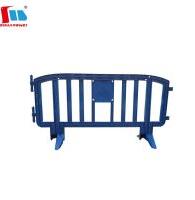Using crowd control barriers is essential for managing and directing the flow of people in various public events, gatherings, and construction sites. These barriers are designed to ensure safety, maintain order, and create organized queues or boundaries. Here's a step-by-step guide on how to effectively use crowd control barriers:
1. Assess the Event or Venue: Before deploying crowd control barriers, assess the event or venue to identify areas that require crowd management. Determine where the barriers are needed to control pedestrian traffic, create designated lines, or secure restricted areas.
2. Proper Placement: Place the barriers strategically to guide people in the desired direction and prevent access to restricted zones. Position the barriers in a straight line to create orderly queues or form barricades around areas that need to be cordoned off.
3. Connect the Barriers: Most crowd control barriers have interlocking mechanisms that allow them to be connected to form a continuous line. Connect the barriers securely to create a solid and stable barrier wall.
4. Use Signage and Tapes: For clear guidance, use signs or directional tapes along with the barriers. Signage can indicate the direction of movement, indicate the start and end points of queues, or display important safety messages.

5. Consider Accessibility: Ensure that there are designated entry and exit points for people to pass through the barriers. Leave gaps or openings for accessibility and emergency access when required.
6. Train Staff and Volunteers: If there are staff or volunteers responsible for managing the crowd, provide them with proper training on how to use the barriers effectively. Train them to handle crowd control situations and direct people in an organized manner.
7. Monitor and Adjust as Needed: Throughout the event or gathering, monitor the crowd flow and adjust the placement of barriers if necessary. Be responsive to changing crowd dynamics and make adjustments to ensure smooth movement and safety.
8. Address Emergencies and Incidents: Have contingency plans in place for emergencies or incidents that may require immediate crowd management. Train staff on how to respond to emergencies and safely guide people in case of evacuations.
9. Disassembly and Storage: After the event or when crowd control is no longer needed, disassemble the barriers carefully. Store the barriers properly to protect them from damage and ensure they are ready for future use.
Tips for Using Crowd Control Barriers:
Use sturdy and durable crowd control barriers to withstand the pressure of crowds and ensure stability.
Consider using barriers with reflective strips or bright colors for better visibility, especially in low-light conditions.
Avoid overcrowding areas with barriers, as it may lead to congestion and safety hazards.
Communicate with the crowd through staff or volunteers to ensure they understand the purpose of the barriers and any necessary instructions.
In conclusion, using crowd control barriers is a crucial aspect of managing crowd movement and ensuring safety in public events, gatherings, and construction sites. By placing the barriers strategically, using signage, and training staff or volunteers, you can effectively guide and control the flow of people, maintain order, and create a safe environment for everyone involved.





Comments
All Comments ( 0 )